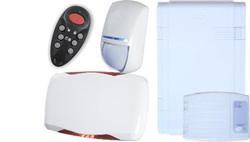
INTRUDER ALARMS / BURGLAR ALARMS
There are two main types of intruder alarm available: Audible Only & Monitored
Audible Only: An audible alarm uses internal and external sounders to signal when an alarm has been activated, relying on noise to alert the local area and scare off an intruder.
Monitored: A monitored alarm contains all the basic components that complete an audible alarm, but as well as relying on noise to scare off a potential intruder and warn people in the local area of an attempted break in, a signal is also sent to an Alarm Receiving Centre (ARC) this signal is then vetted to exclude false alarms (where possible) and passed to the emergency services to attend.
The installation and use of a monitored alarm is governed closely by The Association of Chief Police Officers (ACPO) An alarm system cannot be monitored without Police approval, as without this approval, they will not respond to any calls from the ARC. ACPO lays down many requirements for such alarm installations, such as having your system serviced twice yearly. All these requirements are designed to minimise police false alarms and maximise intruder apprehension.
I want a monitored alarm but don't want to pay through the nose!
You can actually have an audible alarm that is monitored by YOU thus saving yourself money and the benefit of knowing that someone (You) is going to respond.
System Components: What is needed
Alarms are made up from a few basic elements which are selected according to the specific site, although there are many different components that can be installed most residential and business systems will all have one or more of the following equipment:
This alarm system can also include options for Smoke Detectors and Personal Attack Buttons amongst other equipment.
Audible Only: An audible alarm uses internal and external sounders to signal when an alarm has been activated, relying on noise to alert the local area and scare off an intruder.
Monitored: A monitored alarm contains all the basic components that complete an audible alarm, but as well as relying on noise to scare off a potential intruder and warn people in the local area of an attempted break in, a signal is also sent to an Alarm Receiving Centre (ARC) this signal is then vetted to exclude false alarms (where possible) and passed to the emergency services to attend.
The installation and use of a monitored alarm is governed closely by The Association of Chief Police Officers (ACPO) An alarm system cannot be monitored without Police approval, as without this approval, they will not respond to any calls from the ARC. ACPO lays down many requirements for such alarm installations, such as having your system serviced twice yearly. All these requirements are designed to minimise police false alarms and maximise intruder apprehension.
I want a monitored alarm but don't want to pay through the nose!
You can actually have an audible alarm that is monitored by YOU thus saving yourself money and the benefit of knowing that someone (You) is going to respond.
System Components: What is needed
Alarms are made up from a few basic elements which are selected according to the specific site, although there are many different components that can be installed most residential and business systems will all have one or more of the following equipment:
- Control Equipment
- Remote Keypad
- Door Contact
- Passive Infrared Detector (PIR)
- Dual Technology Detector
- Internal and External Sounders
This alarm system can also include options for Smoke Detectors and Personal Attack Buttons amongst other equipment.
